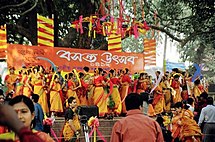| Falgun | |
|---|---|
 Celebration stage of 1st day of Falgun, beginning of spring season in Bangladesh Celebration stage of 1st day of Falgun, beginning of spring season in Bangladesh | |
| Native name | ফাল্গুন (Bengali) |
| Calendar | |
| Month number |
|
| Number of days | 29/30 |
| Season | Spring |
| Gregorian equivalent | February–March |
| Significant days | Chotiro 30 – Choitro Sankranti |
| ← MaghChoitro → | |
Falgun or Phalgun (Bengali: ফাল্গুন; Nepali: फाल्गुण) or Phagun (Assamese: ফাগুন) is the eleventh month of the year in the Bengali calendar, the Assamese calendar, and the Nepali calendar. In the revision of the Bengali calendar used in Bangladesh since October 2019, the month has 29 days in common years or 30 in leap years of the Gregorian calendar. In the previous version of the calendar, used in Bangladesh from 1987 through October 2019, Falgun had 30 days in common years or 31 days in leap years. The month has 29 or 30 days, based on the true movements of the Sun, in the old non-reformed Bengali calendar, still used in West Bengal, and in the Nepali calendar.
Falgun was named for the nakshatra (lunar mansion) Uttara phalguni, in the vicinity of which the full moon appears at that time of the year. It marks the arrival of spring, the sixth and final season in Bangladesh, West Bengal, Assam, and Nepal. Falgun falls between mid-February and mid-March on the Gregorian calendar.
Observances
- Falgun 1 - Pahela Falgun (Bangladesh)
- Falgun 7 – Democracy Day (Nepal)
- Falgun 8
- Language Martyrs' Day (Bangladesh)
- International Mother Language Day (Bangladesh, India)
- Falgun 12 – National Education Day (Nepal)
- Falgun 14 – Maha Shivaratri (India, Nepal)
- Falgun full moon – Dol Purnima (India), Holi (Bangladesh, India)
See also
References
- ^ Gyllenbok, Jan (2018). Encyclopaedia of Historical Metrology, Weights, and Measures. Vol. 1. Birkhäuser. pp. 260–261. ISBN 978-3-319-57596-4.
- Gyllenbok, Jan (2018). Encyclopaedia of Historical Metrology, Weights, and Measures. Vol. 1. Birkhäuser. p. 252. ISBN 978-3-319-57596-4.
- Crump, William D. (2014). Encyclopedia of New Year's Holidays Worldwide. McFarland. p. 38. ISBN 978-1-4766-0748-1.
- ^ "Bangladesh reworks Bangla calendar to match national days with West". bdnews24.com. 17 October 2019.
- Chakrabarti, Kunal; Chakrabarti, Shubhra (2013). Historical dictionary of the Bengalis. Scarecrow Press. pp. 114–115. ISBN 978-0-8108-5334-8.
- Crump, William D. (2014). Encyclopedia of New Year's Holidays Worldwide. McFarland. pp. 26–27. ISBN 978-1-4766-0748-1.
- Jones, Howard D. (2018). "Historical Note: The Origin of the 28 Nakṣatras in Early Indian Astronomy and Astrology". Indian Journal of History of Science. 53 (3): 319. doi:10.16943/ijhs/2018/v53i3/49463. S2CID 134652511.
- Nicholas, Ralph W. (2003). Fruits of Worship: Practical Religion in Bengal. New Delhi: Chronicle Books. p. 27. ISBN 978-81-8028-006-1.
- "Pahela Falgun brings colour in life". The Daily Star. UNB. 13 February 2018.
- "Two Tundikhel events". Nepali Times. 19 February 2021.
- Tithila, Kohinur Khyum (22 October 2019). "Ashshin in 31 days in revised Bangla calendar". Dhaka Tribune.
- Graner, Elvira (July 2006). "Education in Nepal: Meeting or Missing the Millennium Development Goals?". Contributions to Nepalese Studies. 33 (2): 153.
- "Nepal celebrates Mahashivaratri festival". Xinhua News Agency. 20 February 2012.
- MacDonald, Margaret Read, ed. (1992). The Folklore of World Holidays. Gale Research. pp. 144–145. ISBN 0-8103-7577-X.
External links
- "Bangabda". Banglapedia.
| Months of the Bengali calendars | |
|---|---|
| Months of the Nepali calendar | |
|---|---|
This Bangladesh-related article is a stub. You can help Misplaced Pages by expanding it. |
This Nepal-related article is a stub. You can help Misplaced Pages by expanding it. |